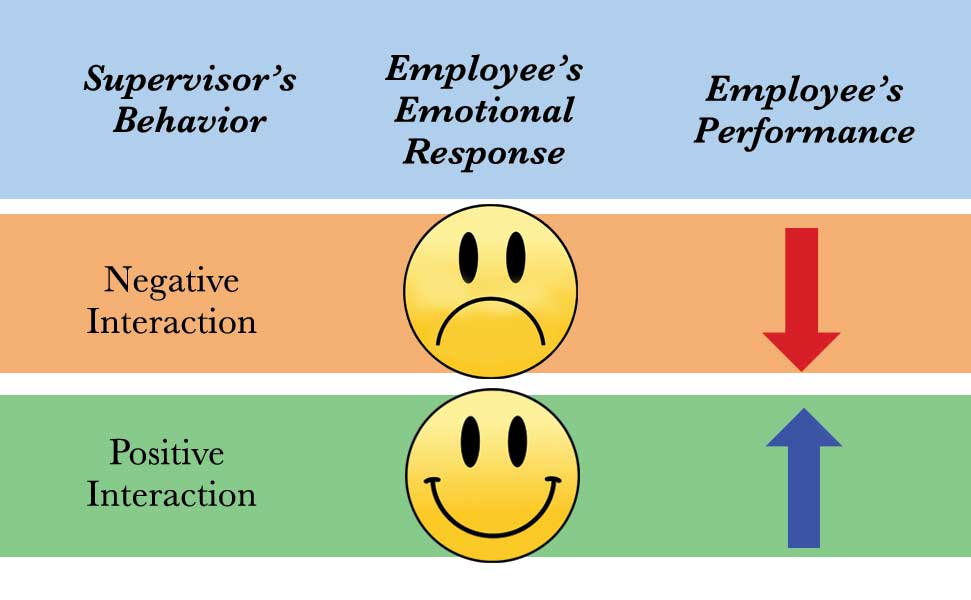By Larry Cole
Ph.D.
TeamMax
The secret is out…engaged employees are more productive and committed to their place of employment both of which lead to increased customer satisfaction and net profits. Yes, and in your industry, engaged employees also work more safely.
In the 30 + years that I’ve worked as a consultant, literally every leader and management structure with whom I’ve worked say that they want an engaged employee, yet Gallup Poll, among others, report that only 35% of employees are engaged with their work. Research also states that at any given time some 60% of the employees are either looking or will take another job if it’s available. What is wrong with this picture? The answer — the way employees are treated! Take a look at this illustration.
I hope I know which of these two scenarios you would like to have. All I’ll say at this point is if you want the top scenario in your company, then something is drastically wrong. Having said that, I’ve seen supervisors who seem to enjoy treating people like a baby treats a diaper! I might add that the higher this person is in the organizational hierarchy, the more damage is done in that company, which highlights the point that fish rot from their head down! For example, an owner of the company that I was asked to work with would enter one of his locations and walk right by employees without acknowledging their presence. He acted like he just didn’t care and that’s the impression his employees had. Let your imagination wonder about his employee turnover rate.
Let’s take a quick look at what is employee engagement. In brief it is a combination of the following three variables and typically measured through an employee survey:
- Physical engagement — the amount of energy directed to work.
- Emotional engagement — the positive feelings associated with employment.
- Cognitive engagement — the degree the employee is focused on their job.
These words sound simple, right? The fact is high employee engagement isn’t just going to happen because you want it to — you are going to have to do something different than you’re doing today.
I just quantified employee engagement for a company in which 60% of the employees strongly agreed being engaged. In spite of the fact that this percentage is considerable higher than what has been reported (i.e., 35%), the CEO was disappointed as he expected a higher number. We’re going to use his disappointment as fuel to propel change.
The space allocated for this article dictates that I be brief as I introduce the two essential tracks to improve employee engagement. One is corporate accountability. That is employee engagement is a regular scheduled agenda item for the senior leaders to review their people metrics in the same fashion as they review their technical metrics. Second is what got you here is not going to get you there in the words of author Marshall Goldsmith. In other words it is time to apply proven techniques that will promote employee engagement. Let me list a few.
- Future. Today’s employees want to be associated with a company that both know what they are striving to be in the future and why. Employees want to apply their skills in a meaningful way to assist the company’s growth. Yes people are hardwired to belong to “something” that is bigger than they are.
- Challenging Work. Employees want a career path that enables them to be challenged and continue to their personal and professional development. You might be surprised to learn that for many employees this fact is more important than a salary increase.
- Communicate. Communication is a two-way street — employees want to “be in on things”. They want to know what is happening in the company. Additionally, being important enough to be asked for their input is one of the crowning jewels to engage employees and using that input solidifies their importance.
- Care. Let me close by discussing the old cliché people don’t care what you know until they know how much you care about them. The people touch is critically important for employee engagement. The company’s owner that I mentioned previously in this article who acted like he didn’t care is an excellent example. If that company quantified employee engagement I doubt that it would even reach the 35% level that researchers discuss.
You have to invest time with your employees to talk to your employees about their family, hobbies, career goals and how being employed with the company can help them achieve their aspirations.
I’m out of space so I’ve got to stop. Thanks for reading and I hope this article stimulates you to create the environment for your employees to become even more engaged, now that you know the secret.

